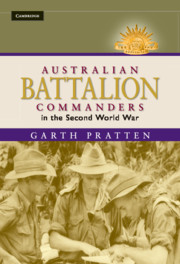Book contents
- Frontmatter
- Dedication
- Epigraph
- CONTENTS
- List of maps and figures
- Military symbols on maps
- ACKNOWLEDGEMENTS
- NOTES ON THE TEXT
- List of abbreviations
- INTRODUCTION
- CHAPTER 1 ‘COMPLETELY UNTRAINED FOR WAR’
- CHAPTER 2 THE FOUNDATIONS OF BATTALION COMMAND
- 3 ‘WE WERE LEARNING THEN’
- CHAPTER 4 DESERT EPILOGUE
- CHAPTER 5 VICTIMS OF CIRCUMSTANCE
- CHAPTER 6 ‘NO PLACE FOR HALF-HEARTED MEASURES’
- CHAPTER 7 ‘THERE IS NO MYSTERY IN JUNGLE FIGHTING’
- CHAPTER 8 ‘EXPERIENCED, TOUGHENED, COMPETENT’
- CONCLUSION
- APPENDIX 1 THE DEMOGRAPHICS OF AUSTRALIAN BATTALION COMMANDERS
- APPENDIX 2 PERIODS OF COMMAND
- NOTES
- BIBLIOGRAPHY
- INDEX
CHAPTER 7 - ‘THERE IS NO MYSTERY IN JUNGLE FIGHTING’
The New Guinea offensives
Published online by Cambridge University Press: 18 December 2014
- Frontmatter
- Dedication
- Epigraph
- CONTENTS
- List of maps and figures
- Military symbols on maps
- ACKNOWLEDGEMENTS
- NOTES ON THE TEXT
- List of abbreviations
- INTRODUCTION
- CHAPTER 1 ‘COMPLETELY UNTRAINED FOR WAR’
- CHAPTER 2 THE FOUNDATIONS OF BATTALION COMMAND
- 3 ‘WE WERE LEARNING THEN’
- CHAPTER 4 DESERT EPILOGUE
- CHAPTER 5 VICTIMS OF CIRCUMSTANCE
- CHAPTER 6 ‘NO PLACE FOR HALF-HEARTED MEASURES’
- CHAPTER 7 ‘THERE IS NO MYSTERY IN JUNGLE FIGHTING’
- CHAPTER 8 ‘EXPERIENCED, TOUGHENED, COMPETENT’
- CONCLUSION
- APPENDIX 1 THE DEMOGRAPHICS OF AUSTRALIAN BATTALION COMMANDERS
- APPENDIX 2 PERIODS OF COMMAND
- NOTES
- BIBLIOGRAPHY
- INDEX
Summary
The campaigns of 1943 and early 1944 marked a period of consolidation for the AMF. With the perceived threat to the Australian mainland defeated, the AMF was able to take time to reflect on how it conducted operations. The desperate days of 1942 had passed, and the AMF was imbued with a sense that it had wrested the initiative from an enemy who could be defeated. The New Guinea offensives, as these operations were dubbed by the Australian official history, demonstrate a more considered approach to warfare. There was a growing realisation that the jungle was not an alien environment, requiring unique doctrine and the desperately light organisations that were a feature of the Papuan operations, but rather one in which an adherence to established tactical and organisational principles remained critical to success on the battlefield. These needed to be adapted and applied, with the judgement born of knowledge and experience, not abandoned in the face of the unexpected or unfamiliar.
Reflecting this shift in attitude, there was an increasing emphasis on training COs and honing their judgement, not solely as jungle masters but as well-rounded infantry commanders. This emphasis was most manifest in the Senior Officers Wing at the Land Headquarters Tactical School. The experience of the New Guinea campaigns also highlighted the strain of long-term operational service on COs and the need to provide them with opportunities to reinvigorate mind and body. It confirmed the notion, established in the Middle East, that credible battalion command was the domain of the young and fit. In the field, the provision of adequate supporting elements, combined with an operational environment in which Australian forces generally held the initiative, meant COs were able to take a step back. Casualty figures readily demonstrate that there had been a change in the nature of the war that the AMF was fighting. Whereas ten COs became casualties at El Alamein and six suffered this fate in Papua, only four COs became battle casualties in New Guinea during 1943–44.
- Type
- Chapter
- Information
- Australian Battalion Commanders in the Second World War , pp. 197 - 234Publisher: Cambridge University PressPrint publication year: 2009



